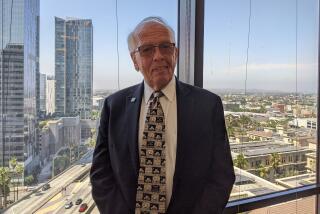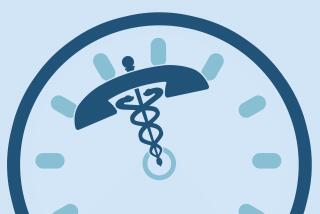Clinic Is a Lifeline for Uninsured
- Share via
I was speaking recently to a business executive in North Carolina who was complaining about the rapidly rising cost of providing medical benefits for his workers. “Nobody goes without health care in this country,” he said. “Somebody will provide it.”
Many others in this country hold a similar view, but having reported on the problems of the uninsured for some years, I know that the truth is much more complex.
Recently I visited T.H.E. Clinic in Southwest Los Angeles, located in a two-story building on Martin Luther King Boulevard. The clinic is a place where the working poor without health insurance go for care: nannies, gardeners, janitors, fast-food and factory workers. The elderly come too. One 83-year-old shuffles in her walker for an hour to travel a few blocks to the clinic.
The clinic’s executive director is Sylvia Drew Ivie, who started her career as a civil rights lawyer and who understands the limits of what community clinics can provide. The clinic’s name, T.H.E., stands for To Help Everyone, but the clinic has the capacity to assist only 10,000 patients a year in a neighborhood where roughly 250,000 people lack health insurance. It is the only nonprofit health center in the area.
“We do a lot, but we fail every day in terms of the quantity of people served, the speed with which we can get specialty care and the limited point of intervention in their lives,” she says. “We need another 10 clinics to take care of half the patients who need care.”
A visit to Ivie’s clinic offers a glimpse of what uninsured people go through to get health care: delays in getting treatment for life-threatening illnesses, in obtaining medications and in gaining access to the latest technology. Like most of the other nonprofit community clinics in Los Angeles County, T.H.E. offers basic primary care and lots of health education. Health-care professionals fan out across the neighborhood urging women to come in for Pap smears and encouraging people to be screened for diabetes. They warn of the dangers of smoking and teach young people about sexually transmitted diseases.
If a clinic patient needs gallbladder surgery, there’s little the clinic can do except try to persuade a physician or hospital to see the patient. “It’s a barter system,” Ivie explains. “We try to be good collaborators with all the providers that might be beneficial to our patients.” The clinic opens its doors to students from big teaching hospitals interested in doing research. In return, the hospitals might provide specialty care. “If it’s an interesting case,” she explains, “they are more inclined to say yes. If it’s run of the mill, they might say no.”
Obtaining referrals to specialists is a huge problem for the county’s uninsured, Ivie says. Her clinic sends many of its patients who require specialty care to County-USC Medical Center, where the backlog for appointments can stretch to several months or more. Other primary-care clinics send thousands of patients there too. Ivie thumbs through the medical file of a 52-year-old woman diagnosed with breast cancer last August. She was unable to get a follow-up appointment with a breast specialist until late January. Then there is the 60-year-old man who was diagnosed by clinic doctors with suspected lung cancer last October. By late January he still hadn’t been seen by a specialist. The paperwork for the referral is missing at County-USC, she said.
Last August, T.H.E. Clinic made an urgent referral to USC for an 11-year-old boy who had drooping eyelids that made it hard for him to see. His appointment is scheduled for this June, nearly a year after he showed up and tried to get care. The family has no money, and the clinic has no eye specialists.
John Wallace, a spokesman for the Los Angeles County Department of Health Services, attributes the appointment backlog to the “sheer volume and chronic under-funding over many decades” for the county health system. He notes that 2 million to 3 million people a year receive outpatient care from county hospitals.
Getting prescription drugs for the clinic’s patients is often a catch-as-catch-can affair. Patients get medicines if the clinic has them in stock. But cash flow problems sometimes make it difficult to keep medicines on the shelf. If the patients are very poor, the clinic tries to give them what they need at no charge. If they can pay, they get prescriptions they can fill on their own.
According to Ivie, patients usually appreciate the personal attention they receive at the clinic. A Vietnamese American couple in their late 50s had no medical care before they spotted an advertisement in a Vietnamese-language newspaper that said the clinic had a staff person who spoke their language.
They’ve come several times, traveling from Orange County. Hiep Ton works in a school cafeteria, and his wife, Thi-Nhung Dinh, was a presser in a clothing factory before a work-related thumb injury forced her to quit.
She has high cholesterol and menopausal symptoms. He has high blood pressure and a cough, which physician assistant Susan Brion diagnosed as a side effect of his medication. Brion told him not to take his friend’s cough medicine and gave him his own prescription.
Each time I visit clinics like Ivie’s I’m struck by the haphazard way they are financed and the lack of resources that this country invests in caring for its neediest. The federal government spends about $1.3 billion on some 3,000 community clinics nationwide. By comparison, Congress gives the National Institutes of Health some $24 billion to develop new drugs and technologies that may never reach those who come to the clinics. T.H.E. clinic receives $270,000 from the federal government, much less than other clinics get. To get more money, it would have to serve more people. To serve more people, it needs more money.
T.H.E. runs on an annual budget of $4 million, patched together from 28 grants and funding sources, both public and private. The money that does come in often depends on the funding organization’s special interest. The clinic may get a grant to do HIV education among Thai American prostitutes and one to prevent smoking among Vietnamese Americans, but it’s a struggle to pay a medical director to work full time. People who use the clinics are the stepchildren of the health-care system, forgotten and invisible. They put up with a standard of care largely unseen by most Americans fortunate enough to have private health insurance.
*
Trudy Lieberman can be reached by e-mail at [email protected]. Health Matters appears on the third Monday of the month.
More to Read
Sign up for Essential California
The most important California stories and recommendations in your inbox every morning.
You may occasionally receive promotional content from the Los Angeles Times.










